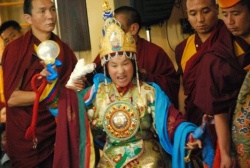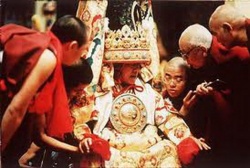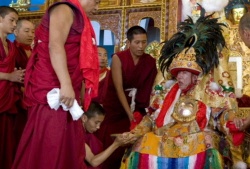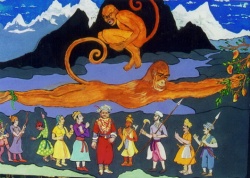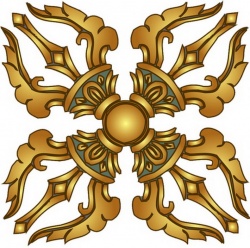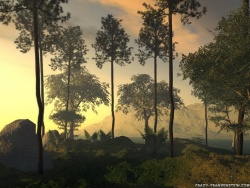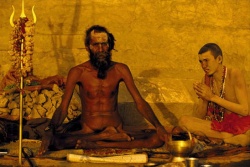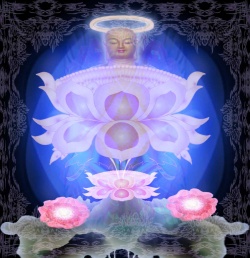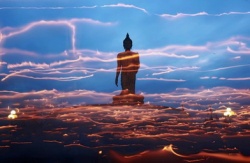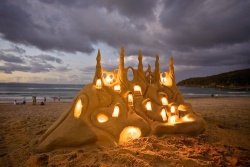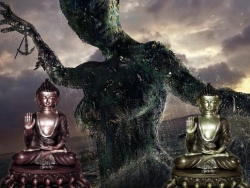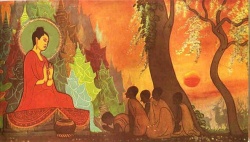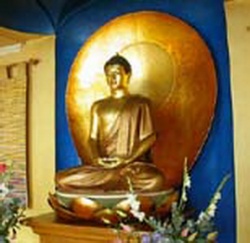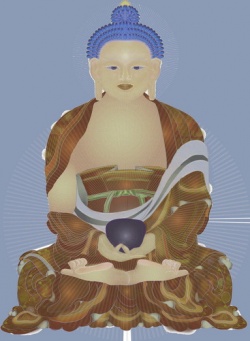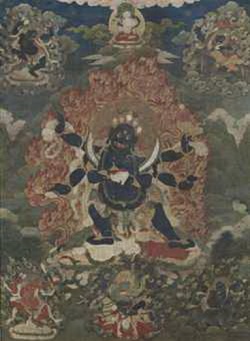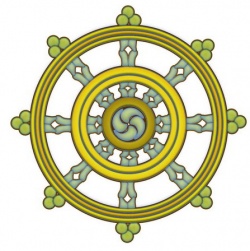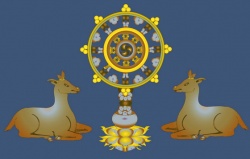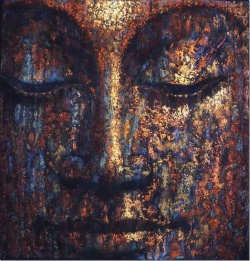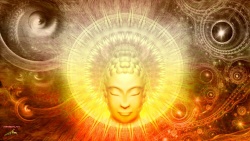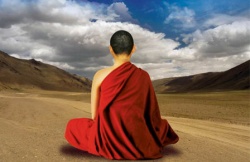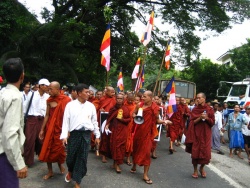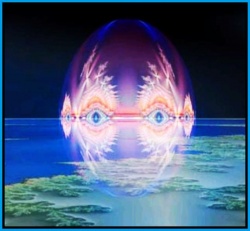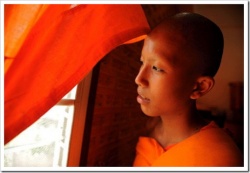The Role of Faith and the Nechung Oracle in Tibetan Culture
In the United States, we pride ourselves on our objectiveness, our ability not to get caught up in religious fervor.
We often think that people who believe deeply in their religion and involve it in all aspects of their lives are "fanatics"—that they are somehow beneath us, less deserving of our respect.
We are taught almost from birth that the scientific method is the only way to look at the world.
We learn the steps of the scientific method (observation, hypothesis, test, and theory) in elementary school.
This philosophy then colors how we think of everything after that.
Faith is seen as an undesirable quality and has no place in our culture. Nothing is real unless it can be proven.
In Tibet, on the other hand, the Tibetan people have a profound respect for their religion. Buddhism permeates every aspect of their lives. As Harrer says in Seven Years in Tibet,
The daily life of Tibetans is ordered by religious belief.
Pious texts are constantly on their lips; prayer wheels turn without ceasing; prayer flags wave on the roofs of houses and the summits of mountain passes; the rain, the win, all the phenomena of nature,
the lonely peaks of the snow-clad mountains bear witness to the universal presence of the gods whose anger is manifested by the hailstorm, and whose benevolence is displayed by the fruitfulness and fertility of the land.
(Harrer, 1953 p 187)
Religion had a part in everything from politics to when they were allowed to change clothing for the season.
One day the summer season was officially declared to have begun, and summer clothes might be worn.
One had no right to leave off one’s furs when one wanted to.
Every year, after considerations of the omens, a day was fixed on which the nobles and monks put on summer dress…Summer dress must be worn from that date only. (Harrer, 1953 p182)
Because religion is such an integral part of their lives, Buddhism unites the Tibetan people.
I propose that the State Oracle in Tibet symbolizes the Tibetan people’s ability to exist in the modern world they have been thrown into since their exile, while at the same time retaining the intense religious faith that defines them as a culture.
Section 1: The Historical Role of the Nechung Oracle
The historical home of the State Oracle of Tibet was Nechung Monastery.
Before the Tibetan diaspora in 1959, Nechung was located four miles west of Lhasa and had since the time of the Thirteenth Dalai Lama supported 115 monks.
Nechung, however, was one of the approximately 6000 monasteries destroyed when the Chinese invaded Tibet in 1949.
The Tibetan people have begun to partially rebuild the monastery in Chinese occupied Tibet, and fortunately,
Of the approximately 70,000 Tibetans who successfully followed the Dalai Lama into exile in 1959 and 1960, an estimated 5,000-7,000 were monks, a tiny fraction of the monastic population of Tibet.
But a disproportionate number of the monks who escaped (and remained monks in exile) were from the ranks of incarnate lamas and the scholarly elite, and they worked to reestablish their monastic institutions (of all sects) in exile.
(Lopez, 1999 p151)
Six monks from Nechung Monastery survived its razing in the Chinese Cultural Revolution and preserved the monastery’s complex rituals and traditions (www.tibet.com/Buddhism/nechung_his.html).
Nechung was rebuilt in Dharamsala, India and currently is home to about seventy monks including the present Medium of the State Oracle, Venerable Thupten Ngodup.
[[Nechung’s] Oracle]], or Kuten as he is called in Tibetan, has traditionally been one of the main advisors to the Dalai Lama and is also consulted during the search for his reincarnation.
Upon the death of the Dalai Lama, the State Oracle is immediately consulted about where the Dalai Lama is going to reincarnate. He gives the search party their first indication of where to begin looking. Harrer says,
Some time before his death, in 1933, the thirteenth Dalai Lama had given intimations regarding the manner of his rebirth.
After his death, the body sat in state at the Potala in traditional Buddha posture, looking toward the south. One morning, it was noticed that his head was turned toward the east.
The State Oracle was straightaway consulted, and while in his trance the monk threw a white scarf in the direction of the rising sun.
(Harrer, 1953 p298)
The regent then went to the sacred lake, Chö Khor Gye to ask for a vision to help in finding the Dalai Lama’s reincarnation. When the search party set out in 1937, they traveled east, in the direction all of the signs had pointed. When they finally found the child incarnation, it was in the east, in China.
The oracle also plays a role in welcoming the newly recognized leader into Lhasa.
Also present was the medium of the chief State Oracle, surrounded by his attendants. As the Dalai Lama’s palanquin arrived, the protective deity abruptly took possession.
Dressed in thick silk robes, a polished silver mirror across his chest and a massive flag-festooned helmet weighing almost a hundred pounds on his head,
the Protector rushed forward, hissing, cheeks puffed, eyes bulging, rhythmically kicking his legs in the air and bending them at the knees in the deity’s honorific dance.
In his hands he held a long white scarf or kata to offer the child. Bowing abruptly from the waist, he snapped his neck down with no difficulty, despite the helmet’s weight,
touched his forehead to the boy’s and presented the scarf, which, calmly accepting, Lhamo Dhondrub then draped around the oracle’s neck in blessing.
(Avedon, 1997 p11)
In addition to participating in the search for the reincarnation of the Dalai Lama and welcoming him to his capital, the Nechung Kuten is also often consulted by the Dalai Lama about important matters such as whether the Chinese were going to invade and whether he should then leave Tibet.
As early as 1945,four years before the end of China’s civil war and with it the inevitable renewal of aggression against Tibet by the victor, the State Oracle had faced eastward in a trance, wildly shaking his head in warning. In 1947, he had prophesied that in the Year of the Iron Tiger—1950—Tibet would face "great difficulty."
(Avedon, 1997 p25)
And as the Dalai Lama said,
Nechung was asked a question about China. Rather than answering it directly, the Kuten turned towards the East and began bending forward violently.
It was frightening to watch, knowing that this movement combined with the weight of the massive helmet he wore on his head would be enough to snap his neck. He did it at least fifteen times, leaving no one in any doubt about where the danger lay.
These prophesies, combined with other perceived signs from the gods of danger for Tibet, such as the earthquake in 1950 in the south of the country, and a second prophesy by the Oracle a few months before the appearance of Chinese soldiers close to the Norbulingka (Avedon, 1997 52) precipitated the Dalai Lama’s flight to India in 1959.
Though there were obviously other factors affecting his decision, the Dalai Lama must have no doubts that he is really hearing the voice of Dorje Drakden when the Oracle speaks in trance, if the he believed the prediction enough to leave the country because of it.
This is symbolic of the Tibetan people in general.
Even though they were unprepared for being forced into the outside world since they had cut themselves off from it for so long, the Tibetans show no signs of being overwhelmed by the wonders modern science.
They still have the complete and utter faith in Buddhism suffusing their lives that Harrer noticed during his stay in Tibet.
In all these years I have never met anyone who expressed the slightest doubt about the truth of the Buddha’s teaching…One cannot close one’s heart to the religious fervor that radiates from everyone.
(Harrer, 1953 p188)
The same feeling is still evident in Dharamsala today, expressed in the same ever-present prayer flags and prayer wheels that were to be seen in Lhasa.
Section 2: Testing the Oracle’s Validity
As was mentioned above, the Nechung medium is believed to be possessed of the spirit of Dorje Drakden when he enters his trance.
When they have to find the a new medium following the Oracle’s death, therefore, it is very important for the Tibetans to be sure that the medium they choose is the one that the god has chosen to speak through.
For this reason, there is an extended series of tests that the prospective Kuten must go through before being confirmed as the Nechung Oracle.
The way in which the mediums are discovered is not the same every time, though in each case it appears that Dorje Drakden takes possession of the new medium he has chosen.
For example, the Thirteenth State Oracle, Lobsang Jigme developed a strange "illness" around his tenth birthday, in which he would sleepwalk and go into seizures where he would shout and thrash about.
Then, when he was fourteen, during one of his trances he began to perform the honorific dance of Dorje Drakden.
This, however, was not enough to put him up as a candidate for being the new medium since he was an unknown, adolescent monk.
Normally candidates are well known mediums of other deities.
The Gadong medium, however, insisted while under possession by Shinjachen that Lobsang Jigme was the chosen medium.
The monks of Nechung monastery tested this proclamation extensively by putting Lobsang Jigme’s name, along with the names of all the other candidates into a vessel and spinning it until one of them came out before they accepted this prophecy.
Lobsang Jigme’s name was always the one that was ejected. (Avedon, 1997 p203-210)
The present State Oracle, Thupten Ngodup, was also possessed by Dorje Drakden before being recognized as the chosen medium, though he experienced no sleepwalking or seizures.
During the ceremony to ask for the blessing of Nechung monastery, which was being performed without a medium since Lobsang Jigme had died and a new medium not yet been found, Thupten Ngodup found himself possessed of by the spirit of Dorje Drakden. (www.tibet.com/Buddhism/nechung_medium.html)
After the medium has been discovered, he must still be tested before he is proclaimed as Nechung’s new Oracle.
The test consists of three main parts.
In the first part, which is considered easy, the prospective Kuten is asked to name the contents of sealed boxes.
Next, he is required to be able to recite verbatim prophecies that he had given on a previous occasion the monks specified.
All of the Oracle’s prophecies were transcribed in massive written texts.
This test was considered nearly impossible to pass unless Dorje Drakden is actually present, as his prophecies are very cryptic and poetic in style.
Thirdly, the medium’s breath is checked to see if it has the faint odor of nectar that is characteristic of possession by Tibet’s Protector.
This last test is considered to be the most accurate and the most definitive.
A final sign that reveals that the spirit of Dorje Drakden had actually possessed the medium is the appearance of the imprint a dorje on the top of his head for several minutes after the trance has ended. (Avedon, 1997 p211-212)
Section 3: The Trance
Extensive preparation and ceremony surround the trance in which the spirit of Dorje Drakden possesses the Nechung Oracle.
During trances entered by Kutens, Tibetan deities
Become incarnate in male and female mediums, who lose consciousness and go into a trance:
the human ego is blotted out, and the medium’s body is used as a support for the deity who fills him and speaks through his mouth.
(Stein, 1972 p187)
Before attempting a trance, the Oracle must purify both his mind and body.
To purify his body, he has stopped eating pork, garlic, onions and other impure foods and eaten off of his own separate set of plates for two days before the trance.
(Avedon, 1997 p191) To complete the preparation, the Kuten must prepare also prepare his mind through practicing deity yoga and meditation techniques to get it into the right state for Dorje Drakden to take possession.
In order to reach the level of trance in which the deity is able to achieve complete control of the medium and transmit his message clearly, the medium has to make sure that "the 72,000 psychic channels upon which, according to tantric theory, consciousness is mounted in the human body [are] clear of all obstructions."
(Avedon, 1997 p211) If he is new to the practice or is not fully prepared, the Kuten can find "the process of clearing the psychic channels or tsa by which the Protector will enter him, extremely painful." (Avedon, 1997 p 198)
In addition, the disposition of the possessing deity also determines whether the trance experience is painful or not.
The Gadong Kuten is possessed by Shinjachen, who is a "manifestly wrathful spirit," and so his trance is always more painful.
(Avedon, 1997 p198) The power of the deity possessing the Kuten also determines whether the experience is painful for him.
On only two occasions a year did Lobsang Jigme experience serious discomfort in his occupation.
At these times, two of the Five Kings, the superiors of Dorje Drakden and Shinjachen, would come with the ministers and very briefly take possession of the Nechung and Gadong mediums.
In the case of the Nechung kuden, Trinley Gyalpo, the Northern King of Action, would follow Dorje Drakden into the medium’s body…
Without the intervening energy of Dorje Drakden to modulate the current of White Pehar, as Trinley Gyalpo was often called, the medium would immediately die…
At the moment of entry, the medium’s body, already swollen from Dorje Drakden, would become rigid, arms and legs outstretched, blood gushing from his nostrils.
(Avedon, 1997 p213)
The reason that Trinley Gyalpo caused the Nechung medium so much pain, even though he is not a "wrathful spirit," is because he is the "superior of Dorje Drakden" and so is much more powerful.
The Kuten’s body is just not really capable of containing him.
After the Nechung medium has completed his preparations and before he actually goes into trance for a formal occasion, he must first put on an elaborate costume.
The costume consists of embroidered robes with flags and victory banners flying from his back:
The Kuten is dressed in an elaborate costume consisting of several layers of clothing topped by a highly ornate robe of golden silk brocade, which is covered with ancient designs in red and blue and green and yellow.
On his chest he wears a circular mirror which is surrounded by clusters of turquoise and amethyst, its polished steel flashing with the Sanskrit mantra corresponding to Dorje Drakden.
Before the proceedings begin, he also puts on a sort of harness, which supports four flags and three victory banners. (www.tibet.com/Buddhism/nechung_hh.html)
The circular mirror on the Oracle’s chest is where he is supposed to see what is in the future for Tibet for the coming year.
As Tung says, the mirror is inscribed with the Sanskrit word khri, which means "attention."
Having finished the necessary meditations, the Oracle is ready to begin the trance.
After he is completely possessed by the spirit of Dorje Drakden, attendant monks place upon his head a massive helmet which is tied so tightly that, were the medium not in trance, it would immediately strangle him.
This is why it must be removed immediately after the Protector releases the Kuten.
The helmet that was used when the ceremony was performed in Tibet weighed eighty to ninety pounds, though the one used today only weighs approximately thirty pounds.
The helmet is just as elaborately decorated as the rest of the Kuten’s costume.
Tung describes:
It was decorated with peacock feathers, cock feathers, and vulture feathers (especially the fluffy feathers from the legs of the vultures—but when these were not available, cotton was substituted), gold, precious stones, and in the center of the crown, an odd piece of red glass said to have an unearthly glow when the oracle was in full trance.
The entire headdress was attached to his head by leather cords wrapped in silk…Its enormous weight could break his neck in a normal state.
(Tung, 1980 p200)
Each part of this costume: the robes, the headdress, weighs a considerable amount. As mentioned above, the helmet weighs around thirty pounds. The robes themselves weigh over one hundred pounds.
(Avedon, 1997 p192) That means the Kuten is supporting approximately one hundred and thirty pounds of extra weight when he is in trance. (www.tibet.com/Buddhism/nechung_hh.html)
In previous times, with the additional weight of the heavier headdress, the outfit the oracle would have been performing in would have amounted to over one hundred and eighty pounds of costume.
When the medium is not in trance, he is barely able to walk in this costume and must be helped to the stool on which he is seated at the start of the ceremony. (www.tibet.com/Buddhism/nechung_hh.html)
The traditions surrounding the consultation of the Nechung Oracle during the Tibetan New Year festivals are very involved. As the Dalai Lama says,
The ceremony begins with chanted invocations and prayers, accompanied by the urgings of horns, cymbals and drums.
After a short while, the Kuten enters his trance, having been supported until then by his assistants, who now help him over to a small stool set before my throne.
Then as the first prayer cycle concludes and the second begins, his trance begins to deepen. (www.tibet.com/Buddhism/nechung_hh.html)
At this point, Dorje Drakden takes control of his body.
When he has completely taken control, several changes take place in the medium.
These signs must be present before questioning of the Oracle takes place.
The signs that the monks look for are the swelling of the medium’s body up to two inches, support of the heavy costume with ease, and the tinkling of bells attached to the helmet’s top and the bouncing of the mirror on his chest due to increased heartbeat. (Avedon, 1997 p211)
As soon as the helmet is fastened upon the Oracle’s head, Dorje Drakden shows that he is fully in possession of his body.
Leaping up, he swings a long sword in his right hand and begins to dance. His movements are martial, wrathful, dignified. They are executed with supernormal precision…
Bending straight down from the waist, he bows low, crossing both arms over his chest, then instantly springs back, the helmet’s mass counting for nothing.
Waving the heavy sword in the air, he first lifts his right leg and arm, the knee and elbow bent, and then his left.
This is the basic step of the cham or ritual dance, interspersed with bows offered out of respect for the Dalai Lama.
Spinning from side to side, he repeats the gestures with such alacrity that the attendants, hovering two feet away, appear to be in another dimension of time, their steps sluggish, their movements coarse in comparison to the frenetic agility before them. (Avedon, 1997 p195)
The Protector then offers scarves to the Dalai Lama and the other main images around the room before hearing questions.
There are normally three questions asked of Dorje Drakden.
The questions are asked in verse about the Tibetan government’s, Tibetan people’s or Dalai Lama’s future.
The questions are about such things as "the appointment of a new governor, the discovery of a new Incarnation, [or] matters involving war and peace." (Harrer, 1953 p202)
The questions are normally spoken out loud, but when greater secrecy is required, they are written on slips of paper and given to the medium. He then puts them under his helmet and answers them without looking at them.
The deity first performs another dance, then responds through the medium offering council, his answers also in verse.
His responses to the questions are recorded by a secretary monk and preserved in Nechung monastery’s records.
After the questions are answered, spirit departs, and the helmet is removed immediately, before it chokes the Kuten.
According to the Dalai Lama, "the oracle’s replies to questions are rarely vague…he is often very specific." (www.tibet.com/Buddhism/nechung_hh.html)
Following the ceremony, the Kuten is taken somewhere where he can rest and is divested of his heavy costume while he recovers. He remembers nothing of what happens during the ceremony.
As Thupten Ngodup says,
Just before the trance, I see and sense what is going around me.
But gradually even my senses disolve and then in a kind of sleep-state I become totally absorbed, and do no t correctly remember what has happened and been said.
Normally, when I am seated on the throne with my costumes on, I do my meditations while reciting the mantras of Hayagriva.
Slowly, I get possessed through a deeper state of absorption, and then gradually feel distant from my own identity and surroundings.
It is like having a dream and not remembering it the next morning.
The same is the case with me before and after I come out of trance.
(www.tibet.com/Buddhism/nechung_medium.html)
It is preferred that he attempt to get into the deepest trance, in which he is completely possessed and unconscious because,
As the most delicate policies of state, both domestic and foreign were involved with the oracle, the possibility of a leak, either from a malignant spirit taking possession (and subsequently, relating information via another medium) or
from the medium himself retaining some trace memory of the trance, was ever-present.
(Avedon, 1997 p211)
The reasoning behind this precaution is obvious, in that, since the Oracle’s prophecies would be used for everything from deciding matters of foreign affairs to determining where a powerful Lama had reincarnated.
Just as with any other nation’s matters of state, it would be very disadvantageous if the information obtained from the Oracle was made public knowledge.
The prophecies made by the Nechung Oracle are often of great service to Tibet.
For example, as mentioned before, the Oracle plays an important role in the search for the Dalai Lama’s reincarnation.
He also prophesied the invasion by the Chinese in 1947, and advised the Dalai Lama about when he should leave Tibet.
When, in 1951, the United States convinced the Dalai Lama that he should go to the US for sanctuary, he changed his mind and decided to remain in Tibet because,
"The State Oracle was consulted and on two occasions instructed Tibet’s ruler to return."
It wasn’t until 1957, after the Oracle had advised that it was time for him to leave did he actually flee to India (Avedon, 1997 p36, 52) following the path advised by the Oracle (www.tibet.com/Buddhism/nechung_his.html)
Dorje Drakden also foretold when and how his medium should leave Tibet as well. When asked what his Oracle should do,
Dorje Drakden replied that after Lobsang Jigme recovered form possession, he should leave Drepung immediately and begin walking south.
He was to follow the same route the Dalai Lama had taken.
The Protector guaranteed that nothing untoward would happen, and then, wrapping blessed barley grains in a white scarf which he gave to the attendants, he instructed them to burn a single grain whenever difficulty was encountered.
Whatever thoughts occurred to them at the moment, he said, they should immediately act on.
(Avedon, 1997 p216)
The Kuten followed his deity’s instructions and, after narrowly escaping capture on numerous occasions, made it to Mussoorie, where the Dalai Lama was staying, safely.
He then continued to serve as the State Oracle of Tibet until his death in 1984.
Section 4: Conclusions and The Future of the Oracle
The Dalai Lama is very interested in modernizing his country while at the same time preserving the traditional Buddhist culture. He has supported the establishment of many organizations dedicated to this goal.
A few of these organizations are the Library of Tibetan Works and Archives,
which holds ancient cultural objects and Tibetan books and manuscripts; the Tibetan Institute of Performing Arts, which preserves musical, dance, and theatrical traditions from Tibet;
and the Norbulingka Institute, which attempts to preserve the roots of Tibetan culture while in exile.
In addition, the Amnye Mahcen Institute and the soon to be completed Center for Higher Tibetan Learning are actively studying the Tibetan culture both inside and outside of Tibet as well as translating Western literature and culture into Tibetan so the Tibetan people can learn about it.
For this reason, I think that the State Oracle of Tibet will continue to be an influential figure in Tibetan culture, though he many not forever continue to play such an important role in decision making.
The Dalai Lama is attempting to make the government of his country more democratic.
At the same time, Tibet is becoming more Westernized and, at least in the younger generations, more secular.
As these young people grow up to become the new political leaders of the country, they are going to bring with them more doubts about the place of religion in government.
If the Dalai Lama succeeds in making his country democratic, eventually, I see the State Oracle taking on a more symbolic role in the future. This, of course, will take a very long time.
A tradition that has been in place since 1544 AD (www.tibet.com/Buddhism/nechung_mediums.html) does not become insignificant overnight.
While the Nechung Oracle’s role in politics will grow smaller, he is an important part of Buddhist tradition just as much as ancient artifacts and manuscripts are.
I think that the Dalai Lama will try to preserve this tradition with as much, if not more, intensity.
The Oracle symbolizes the Tibetan people’s quest to preserve their faith while surrounded by the overwhelming influence of Western scientific culture.
He does something that cannot be explained by the scientific method.
There is no way to test whether he is actually possessed by a god, or if he is simply undergoing a very public seizure.
There is no way to tell how he predicts the future, or whether he actually does.
I am saying that it really doesn’t matter at all. The important thing is that he provides a physical manifestation of the Buddhist faith.
Whether he is the mouthpiece of a god, the Tibetans believe that he is, and the ceremony surrounding his prophesies provides a solid base for their faith as they become more and more exposed to a culture that thrives on the requirement of physical proof.
Works Cited
- Asian Religions in Practice. Ed. Donald S. Lopez, Jr. Princeton University Press: Princeton, NJ, 1999.
- Avedon, John F. In Exile from the Land of Snows. Harper Collins Publishers: USA, 1997.
- Harrer, Heinrich. Seven Years In Tibet. Penguin Putnam Inc.: New York, NY, 1981.
- Stein, R. A. Tibetan Civilization. Stanford University Press: Stanford, CA, 1972.
- Topping, Audrey. The Splendors of Tibet. SINO Publishing Company: New York, NY, 1980.
- Tung, Rosemary Jones. A Portrait of lost Tibet. Snow Lion Publications: Ithaca, NY, 1980.
- www.tibet.com/Buddhism/nechung_his.html
- www.maui.net/~tsurphu/karmapa/prophecies.html
- www.tibet.com/dasaguide.html
- www.tibet.com/Buddhism/nechung_hh.html
- www.tibet.com/Buddhism/nechung_mediums.html
- www.tibet.com/Buddhism/nechung_exile.html
- www.tibet.com/Buddhism/nechung_medium.html
Source
"The Role of Faith and the Nechung Oracle in Tibetan Culture." 123HelpMe.com. 31 Jul 2014 <http://www.123HelpMe.com/view.asp?id=29590>.
